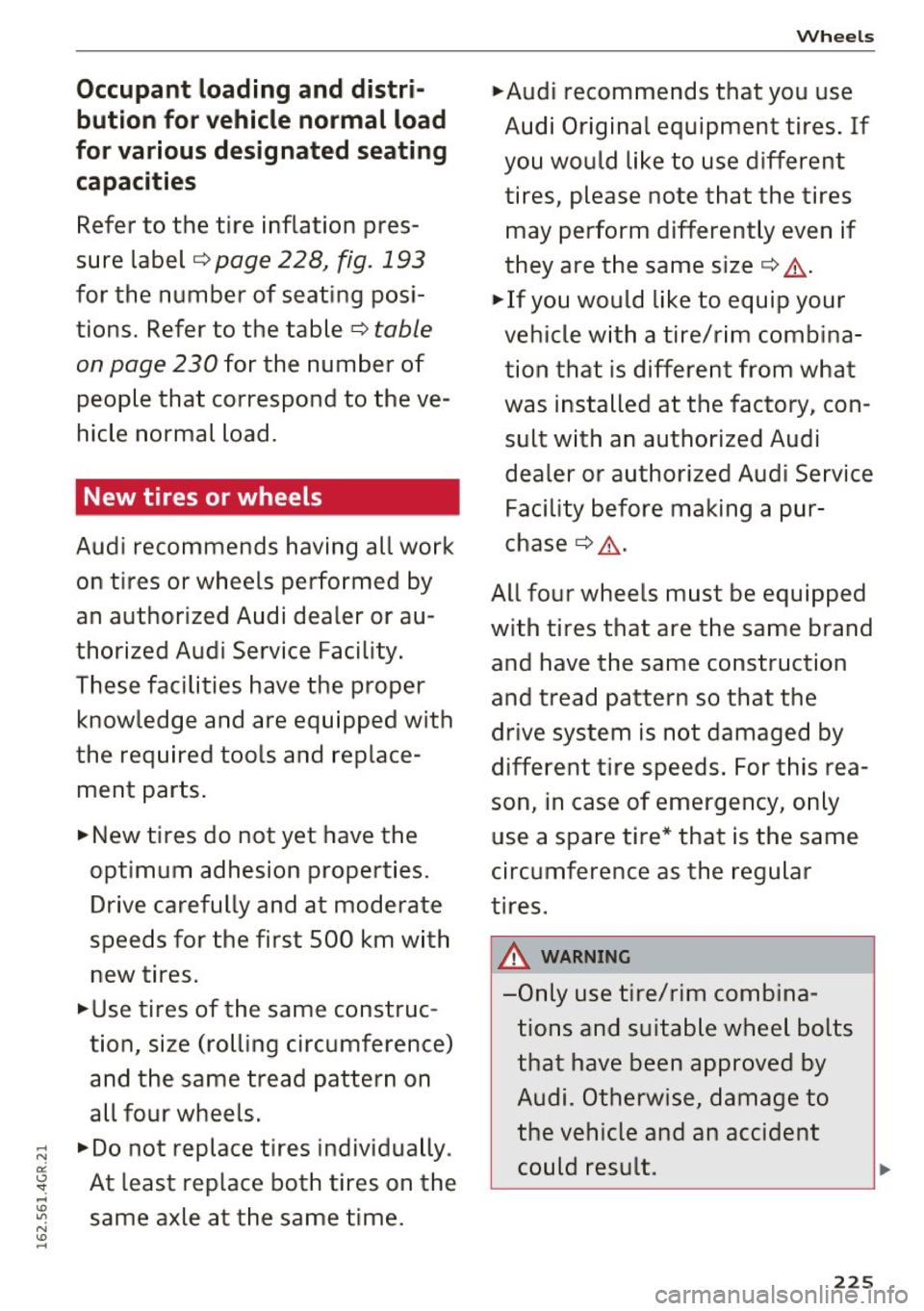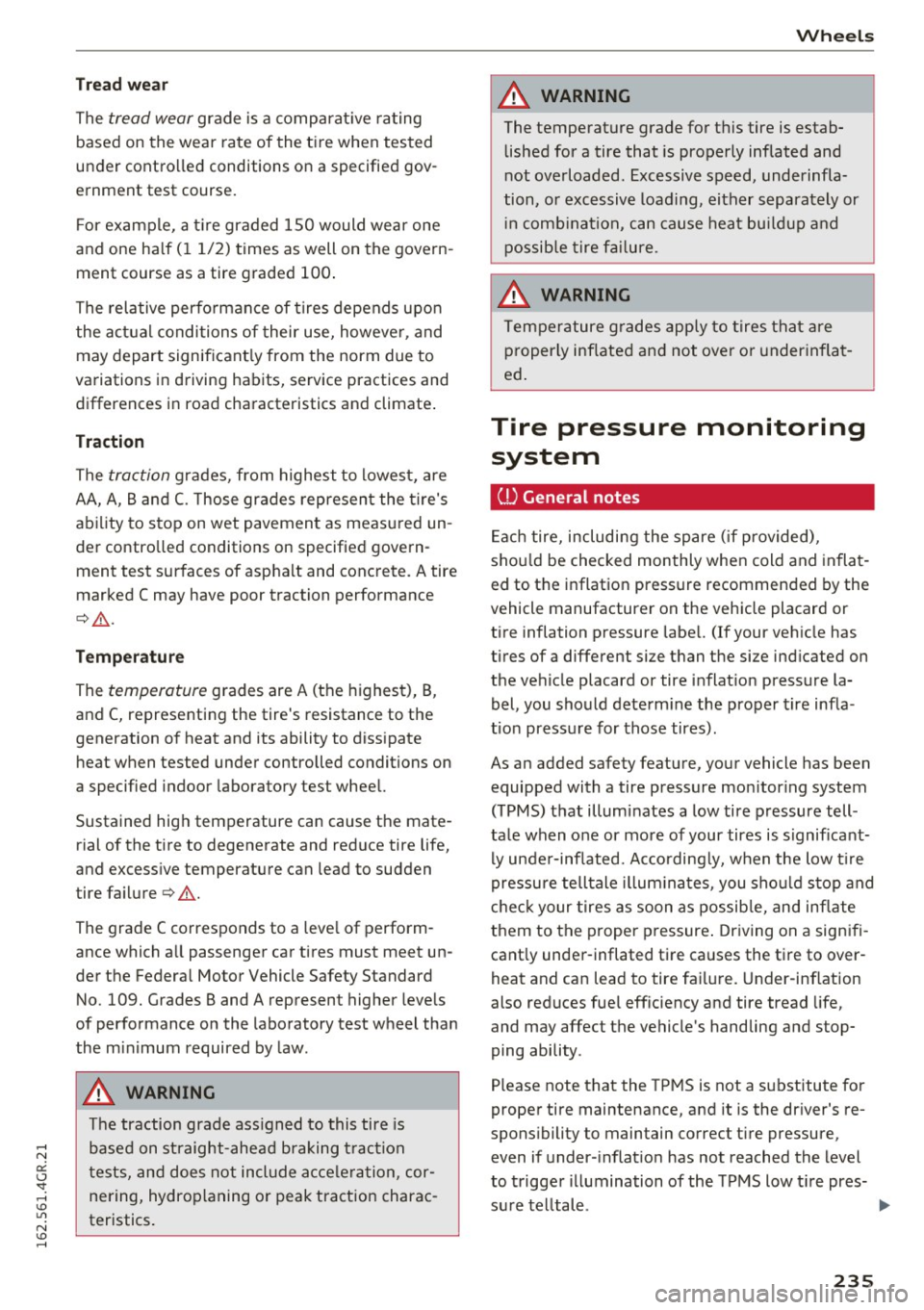spare wheel AUDI RS7 SPORTBACK 2016 Owners Manual
[x] Cancel search | Manufacturer: AUDI, Model Year: 2016, Model line: RS7 SPORTBACK, Model: AUDI RS7 SPORTBACK 2016Pages: 282, PDF Size: 70.78 MB
Page 227 of 282

Occupant loading and distriĀ
but ion for vehicle normal load
for various design ated se ating
c a pa cit ies
Refer to the tire inflation presĀ
sure label Ā¢
page 228, fig. 193
for the number of seating posiĀ
tions. Refer to the table Ā¢
table
on page 230
for the number of
people that correspond to the veĀ
hicle normal load.
New tires or wheels
Audi recommends having all work
on tires or wheels performed by
an authorized Audi dealer or auĀ
thorized Audi Service Facility .
These facilities have the proper
knowledge and are equ ipped with
the required tools and replaceĀ
ment parts .
.,,. New tires do not yet have the
opt imum adhesion properties.
Drive carefully and at moderate
speeds for the first 500 km w ith
new tires.
... use tires of the same construcĀ
tion, size (rolling circumference)
and the same tread pattern on
all four wheels.
;;:: .,,.Do not replace tires individually .
oi
~ At least replace both tires on the ....
~ same axle at the same time. N
"' ....
Wheels
.,,.Audi recommends that you use
Audi Original equipment tires. If
you would like to use different
tires, please note that the tires may perform differently even if
they are the same size Ā¢
A-
.,,. If you would like to equip your
vehicle w ith a tire/r im combinaĀ
tion that is different from what
was installed at the factory, conĀ sult with an authorized Audi
dealer or authorized Aud i Service
Facility before making a pur Ā
chaseĀ¢
A -
All four wheels must be equipped
with tires that are the same brand
and have the same construction
and tread pattern so that the
drive system is not damaged by
different tire speeds. For this reaĀ
son, in case of emergency, only use a spare tire* that is the same
circumference as the regular
tires.
,& WA RNING -
-Only use tire/rim combinaĀ
tions and suitable wheel bolts
that have been approved by Audi. Otherwise, damage to
the vehicle and an accident could result .
225
Page 237 of 282

Tread wear
The
tread wear grade is a comparative rating
based on the wear rate of the tire when tested
under controlled conditions on a specified govĀ
ernment test course.
F or example, a t ire graded 150 would wear one
and one half (11/2) times as well on the governĀ
ment course as a tire graded 100 .
The relative performance of tires depends upon
the actual conditions of their use, however, and
may depart significantly from the norm due to
variations in driving habits, service practices and
differences in road characteristics and climate .
Traction
The
traction grades, from highest to lowest, are
AA, A, Band
C. Those grades represent the tire's
ability to stop on wet pavement as measured un Ā
der controlled conditions on specified governĀ ment test surfaces of asphalt and concrete. A tire
marked C may have poor traction performance
Ā¢ .&, .
Temperatur e
The
temperature grades are A (the highest), B,
and C, representing the tire's resistance to the
generation of heat and its ability to dissipate heat when tested under controlled conditions on
a specified indoor laboratory test wheel.
Sustained high temperature can cause the mateĀ rial of the tire to degenerate and reduce tire life,
and excessive temperature can lead to sudden
tire failure
c:> .&, .
The grade C corresponds to a level of performĀ
ance which all passenger car tires must meet unĀ
der the Federal Motor Vehicle Safety Standard No. 109. Grades Band A represent higher levels
of performance on the laboratory test wheel than
the minimum required by law.
A WARNING
-
The traction grade ass igned to this tire is
based on straight-ahead braking traction
tests, and does not include acceleration, corĀ
nering, hydroplaning or peak traction characĀ
teristics.
Wheels
A WARNING
The temperature grade for this tire is estabĀ lished for a tire that is properly inflated and
not overloaded. Excessive speed, underinflaĀ
tion, or excessive loading, either separately or
i n comb inat ion, can cause heat buildu p and
possible tire failure.
A WARNING
-
-
Temperature grades apply to tires that are
properly inflated and not over or underinflatĀ
ed.
Tire pressure monitoring system
ill General notes
Each tire, including the spare (if provided),
shou ld be checked monthly when cold and inflatĀ
ed to the inflation pressure recommended by the
vehicle manufacturer on the vehicle placard or
tire inflation pressure label. (If your vehicle has
tires of a different size than the size indicated on
the vehicle placard or tire inflation pressure laĀ
bel, you should determine the proper tire infla Ā
t ion pressure for those tires).
As an added safety feature, your vehicle has been equipped with a tire pressure monitor ing system
(TPMS) that illuminates a low tire pressure tellĀ
tale when one or more of your tires is significantĀ ly under -inf lated. Accordingly, when the low t ire
pressure telltale illuminates, you should stop and
check your tires as soon as possib le, and inflate
them to the proper pressure . Driving on a signifiĀ
cant ly under-inflated tire causes the tire to overĀ
heat and can lead to tire failure. Under-inflation
also reduces fue l efficiency and tire tread life,
and may affect the vehicle's handling and stopĀ
ping ability .
Please note that the TPMS is not a substitute for
proper tire maintenance, and it is the driver's reĀ
sponsibility to maintain correct tire pressure,
even if under-inflation has not reached the level
to trigger illumination of the TPMS low tire pres-
sure telltale . .,.
235
Page 248 of 282

Emergency assistance
-Passengers must not remain in the vehicle
when it is jacked up.
- Make sure that passengers wait in a safe
place away from the vehicle and well away
from the road and traffic.
- Make sure jack posit ion is correct, adjust
as necessary and then continue to raise
the jack.
- Changes in temperature or load can affect
the height of the vehicle.
(D Note
Do not lift the vehicle by the sill. Position the
vehicle jack only at the designated lifting
points on the sill. Otherwise, your vehicle will
be damaged.
@ Tips
The vehicle jack mode* switches off automatiĀ
cally at speeds
above 6 mph (10 km/h).
Removing and installing the sill extension
cover
Applies to: vehicles w ith sil l extension
Fig. 205 Sill: removing the cover
.,. Pull the cover down to remove it. c:> fig. 205
.,. To install the cover, insert i t in the mount and
press it upward until it clicks into place. The
cover must be flush with the surface of the sill
extension .
1
> A pp lies to vehicles wit h c eramic brake ro tor s*: Use a secĀ
on d alig nment pin* (sto re d in th e spare w hee l w ell mold Ā
in g) fo r the lower hole, foll ow in g t he descrip tion for the
firs t alig nm ent pin.
246
@ Tips
Some models may also have a cover for the
rear vehicle lift point.
Taking the wheel off/installing a wheel
Follow these instructions step -by-step for changĀ
ing the wheel.
Fig. 206 Changing a wheel : using the sc rewdr iver han d le
(wi th t he blade re m oved) to turn the bol ts
Fig. 207 Changing a wh eel: alignment pin in side the t op
ho le
After you have loosened all wheel bolts and
raised the vehicle off the ground,
remove and reĀ
place the wheel as follows:
Removing the wheel
.,. Use the hexagonal socket in the screwdriver
handle
to completely remove the topmost
wheel bolt and set it aside on a
clean surface
c::> fig. 206.
.,. Sc rew the threaded end of the alignment pin
from the tool kit hand-t ight into the empty bolt
hole
Ā¢ fig . 2011>. .,.